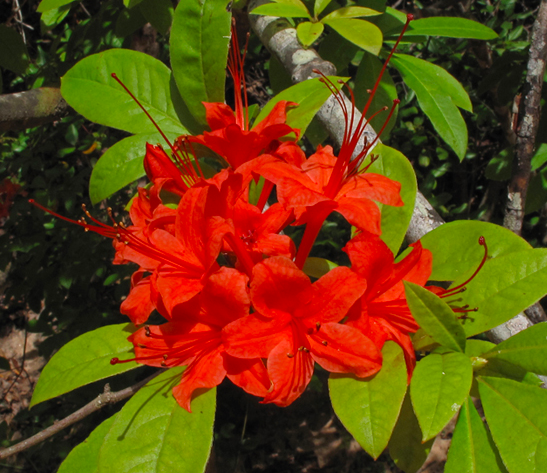For the most part, I’m happy to see any flower, any time of the year but when it comes to azaleas, I have to admit to a certain old – fashioned preference for keeping azaleas as belles of the ball in spring.
Seeing azaleas bloom in fall just seems to be out of the natural order of things, like keeping the Christmas tree up until Valentines’ Day.

Obviously, I’m in the minority here. Recently, as in the last 20 years, the nursery industry has gone ga-ga over Encore azaleas that bloom in spring, a bit in midsummer and then again in fall. There are countless cultivars now, offering these repeat bloomers in every color and size.

I don’t object to a few sporadic blooms on a shrub as the weather cools, sort of a last hurrah! before winter comes but to have a bush laden with pink or white flowers in front of trees sporting brilliantly colored autumn leaves kind of makes me shudder.

Nature herself puts up a good argument for fall blooming azaleas as the stunningly beautiful native plum leaf azalea, Rhododendron prunifolium, naturally blooms in late summer and early fall. This gorgeous shrub, with its bright red blooms, is native to a tiny section of southeastern Alabama and southwestern Georgia. It is definitely a fall blooming azalea that I am excited about. But with it’s brilliant, dark blossoms, it looks as if it should bloom in fall.

I know, I should be grateful for plants that extend the season, that offer beauty for as long as possible and that provide blossoms until frost. And I am. Sort of. Encore and the other fall blooming azaleas are great for other people’s gardens. But for me? I’ll take my azaleas with their lovely spring colors – in spring. But then again, I take down my Christmas tree the day after Christmas! It’s just the natural order of things.
P.S. Last week I wrote about caterpillars and today as my sister and I were walking down a gravel road, we saw a caterpillar that stopped us in our tracks. A full six inches long with spikes and horns, we stood and watched in amazement as it crawled across the road. A little research helped us determine that it is, without a doubt, a “Horned Hickory Devil,” caterpillar to the royal walnut moth. In spite of it’s ferocious appearance, it is pretty harmless. But impressive!!!!


I have to agree about the unexpected sight of a fall blooming pink azalea! There are several in a neighbors yard and I am still surprised to see them bloom when I am looking for leaves changing color and the rusty, golden days of Autumn!
For the same reason, I don’t like to see pansies in the winter—or any flowers, really. They steel the thunder from those first manzanita blossoms and grouse flowers in the spring.
Your article has me chuckling, as I have known you to take down your Christmas tree on Christmas DAY, not the day after. 😉
Couldn’t agree more! Don’t like’em.
Are the Encores of weaker constitution than the Spring only varieties? I have a crop of Encores dying off very slowly, limb by limb, as they are trying to put out just a little more color this late summer. It is taking 2-3 years for them to look like they are giving up. Though they may seem out of place, I thanked them that they were trying! Are they going or approaching gone?